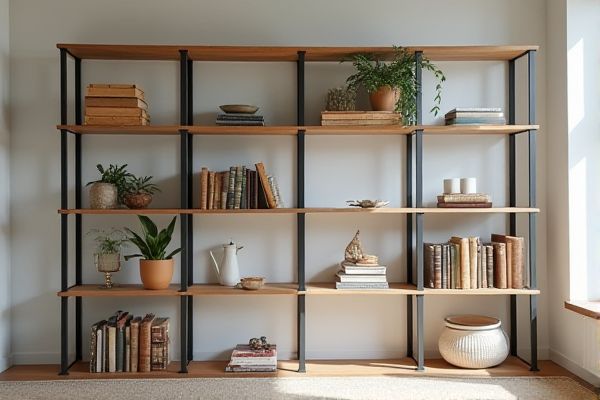
Quadrant shelving offers a curved design that maximizes corner space with a smooth, modern aesthetic, while ladder shelving features a tiered, angled structure ideal for displaying items in an open and accessible way. Explore the rest of the article to discover which shelving option best suits your space and style needs.
Table of Comparison
| Feature | Quadrant Shelving | Ladder Shelving |
|---|---|---|
| Design | Curved, rounded edges designed to fit in corners | Open, angled shelves resembling a ladder |
| Space Utilization | Optimizes corner space, ideal for small rooms | Vertical storage maximizing wall space |
| Material | Wood, metal, or plastic, often solid | Wood or metal frame with open shelving |
| Stability | Stable due to four contact points | Less stable, leans against a wall |
| Usage | Display items, books, decor in corners | Display plants, books, decorative items |
| Assembly | Moderate complexity, fixed design | Easy assembly, lightweight |
| Style | Modern to traditional, blends with decor | Contemporary, minimalist appeal |
| Cost | Generally higher due to design and material | Usually affordable and versatile |
Introduction to Shelving Solutions
Quadrant shelving offers curved, space-efficient storage ideal for maximizing corner areas, while ladder shelving features an open, tiered design that emphasizes easy access and display. Both solutions cater to distinct organizational needs: quadrant shelving optimizes compact spaces, and ladder shelving provides a stylish, accessible option for books or decorative items. Your choice depends on available space and desired aesthetic, ensuring functional and visually appealing storage.
What is Quadrant Shelving?
Quadrant shelving is a space-efficient storage solution characterized by its curved front edges, designed to fit seamlessly into corner areas. This type of shelving maximizes corner space utilization in rooms, offices, or retail settings, offering both functionality and aesthetic appeal. Unlike ladder shelving, which typically features open, straight-lined frameworks, quadrant shelving provides smooth, rounded storage surfaces ideal for compact and stylish organization.
What is Ladder Shelving?
Ladder shelving is a stylish and versatile storage solution featuring a frame that leans against a wall, with shelves decreasing in depth from bottom to top, resembling a ladder's steps. This design maximizes vertical space, making it ideal for displaying books, plants, or decorative items without overwhelming your room. You can easily integrate ladder shelving into various interior styles, from modern minimalism to rustic charm.
Design and Aesthetic Differences
Quadrant shelving features curved, rounded edges that create a soft, elegant look ideal for contemporary or minimalist interiors, while ladder shelving offers a more linear, open-frame design that adds an industrial or rustic charm to your space. Quadrant shelves often fit snugly into corners, maximizing space with a seamless, integrated aesthetic, whereas ladder shelves lean against walls, providing a visually lighter, tiered display. Your choice between the two depends on whether you prefer smooth, flowing shapes or structured, geometric lines to enhance your room's visual appeal.
Space Optimization: Quadrant vs. Ladder Shelving
Quadrant shelving maximizes space efficiency by utilizing corner areas, making it ideal for small rooms and tight spaces where every inch counts. Ladder shelving offers an open, tiered design that provides versatile storage but requires more wall space and does not exploit corners as effectively. For optimal space optimization, choosing quadrant shelving helps achieve better utilization of awkward or limited areas compared to ladder shelving.
Installation and Maintenance
Quadrant shelving typically requires professional installation due to its curved design and fixed dimensions, ensuring stability and proper fit in corner spaces, while ladder shelving offers simpler assembly with adjustable shelves that you can maintain yourself. Maintenance for quadrant shelving involves regular checking of joints and brackets for wear, whereas ladder shelving's open structure allows for easy cleaning and quick replacement of individual shelves if damaged. Your choice depends on whether you prefer a more permanent, secure setup or flexible, user-friendly maintenance.
Durability and Material Considerations
Quadrant shelving typically features curved metal or wood frames that offer robust durability and resistance to wear, making it ideal for long-term use in both residential and commercial settings. Ladder shelving often uses lighter materials like pine or MDF, which may be less durable but provide a modern aesthetic and easier mobility. Choosing between quadrant and ladder shelving depends on the specific material composition and the expected load capacity for your storage needs.
Cost Comparison
Quadrant shelving typically incurs higher costs due to its curved design and specialized manufacturing process, making it more expensive than ladder shelving. Ladder shelving offers a budget-friendly option with simpler construction and readily available materials, resulting in lower overall expenses. Businesses must evaluate project requirements and budget constraints to select the optimal shelving solution.
Ideal Use Cases for Each Shelving Type
Quadrant shelving excels in corner spaces, making it ideal for maximizing storage in compact or awkwardly shaped rooms such as small offices or kitchens. Ladder shelving suits open, modern interiors where both aesthetics and easy access to displayed items are important, often used in living rooms or retail environments. Your choice depends on whether you prioritize space optimization with quadrant shelving or visual appeal and accessibility with ladder shelving.
Choosing the Best Shelving for Your Space
Quadrant shelving offers curved corners that maximize space efficiency and fit seamlessly into room edges, making it ideal for tight or irregular spaces. Ladder shelving provides an open, tiered design perfect for displaying decorative items or books while maintaining a lightweight appearance, best suited for larger or more open areas. Selecting between quadrant and ladder shelving depends on spatial layout, desired storage capacity, and aesthetic preferences to optimize functionality and style.
 homyna.com
homyna.com